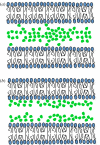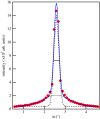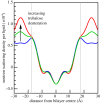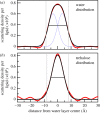Localization of trehalose in partially hydrated DOPC bilayers: insights into cryoprotective mechanisms
- PMID: 24647907
- PMCID: PMC4006246
- DOI: 10.1098/rsif.2014.0069
Localization of trehalose in partially hydrated DOPC bilayers: insights into cryoprotective mechanisms
Abstract
Trehalose, a natural disaccharide with bioprotective properties, is widely recognized for its ability to preserve biological membranes during freezing and dehydration events. Despite debate over the molecular mechanisms by which this is achieved, and that different mechanisms imply quite different distributions of trehalose molecules with respect to the bilayer, there are no direct experimental data describing the location of trehalose within lipid bilayer membrane systems during dehydration. Here, we use neutron membrane diffraction to conclusively show that the trehalose distribution in a dioleoylphosphatidylcholine (DOPC) system follows a Gaussian profile centred in the water layer between bilayers. The absence of any preference for localizing near the lipid headgroups of the bilayers indicates that the bioprotective effects of trehalose at physiologically relevant concentrations are the result of non-specific mechanisms that do not rely on direct interactions with the lipid headgroups.
Keywords: anhydrobiology; cryobiology; cryoprotection; lipid membrane; membrane diffraction.
Figures




Similar articles
-
Direct Comparison of Disaccharide Interaction with Lipid Membranes at Reduced Hydrations.Langmuir. 2015 Aug 25;31(33):9134-41. doi: 10.1021/acs.langmuir.5b02127. Epub 2015 Aug 11. Langmuir. 2015. PMID: 26225718
-
Water replacement hypothesis in atomic details: effect of trehalose on the structure of single dehydrated POPC bilayers.Langmuir. 2010 Jul 6;26(13):11118-26. doi: 10.1021/la100891x. Langmuir. 2010. PMID: 20550154
-
Do trehalose and dimethyl sulfoxide affect intermembrane forces?Cryobiology. 1994 Dec;31(6):531-9. doi: 10.1006/cryo.1994.1064. Cryobiology. 1994. PMID: 7835052
-
Structure and functional properties of diacylglycerols in membranes.Prog Lipid Res. 1999 Jan;38(1):1-48. doi: 10.1016/s0163-7827(98)00021-6. Prog Lipid Res. 1999. PMID: 10396601 Review.
-
The role of trehalose in the physiology of nematodes.Int J Parasitol. 1997 Feb;27(2):215-29. doi: 10.1016/s0020-7519(96)00151-8. Int J Parasitol. 1997. PMID: 9088992 Review.
Cited by
-
Toward the Fabrication of Advanced Nanofiltration Membranes by Controlling Morphologies and Mesochannel Orientations of Hexagonal Lyotropic Liquid Crystals.Membranes (Basel). 2017 Jul 21;7(3):37. doi: 10.3390/membranes7030037. Membranes (Basel). 2017. PMID: 28753973 Free PMC article. Review.
-
Enzyme-Assisted Synthesis of High-Purity, Chain-Deuterated 1-Palmitoyl-2-oleoyl-sn-glycero-3-phosphocholine.ACS Omega. 2020 Aug 26;5(35):22395-22401. doi: 10.1021/acsomega.0c02823. eCollection 2020 Sep 8. ACS Omega. 2020. PMID: 32923797 Free PMC article.
-
Effect of Monosaccharides Including Rare Sugars on the Bilayer Phase Behavior of Dimyristoylphosphatidylcholine.Membranes (Basel). 2024 Dec 3;14(12):258. doi: 10.3390/membranes14120258. Membranes (Basel). 2024. PMID: 39728708 Free PMC article.
-
In Situ SAXS Measurement and Molecular Dynamics Simulation of Magnetic Alignment of Hexagonal LLC Nanostructures.Membranes (Basel). 2018 Dec 2;8(4):123. doi: 10.3390/membranes8040123. Membranes (Basel). 2018. PMID: 30513837 Free PMC article.
-
Temperature Matters: Bacterial Response to Temperature Change.J Microbiol. 2023 Mar;61(3):343-357. doi: 10.1007/s12275-023-00031-x. Epub 2023 Apr 3. J Microbiol. 2023. PMID: 37010795 Review.
References
-
- Koster KL, Webb MS, Bryant G, Lynch DV. 1994. Interactions between soluble sugars and POPC (1-palmitoyl-2-oleoylphosphatidylcholine) during dehydration: vitrification of sugars alters the phase behavior of the phospholipid. Biochim. Biophys. Acta Biomembr. 1193, 143–150. (10.1016/0005-2736(94)90343-3) - DOI - PubMed
Publication types
MeSH terms
Substances
LinkOut - more resources
Full Text Sources
Other Literature Sources

